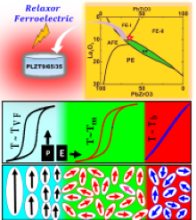Effect of polar nano region dynamics on pyroelectric energy conversion efficiency of doped BaTiO3
| Abstract | Ferroelectrics, which exhibit spontaneous ordering of electrical dipoles below a certain critical temperature, are promising candidates in the field of green – solid state – refrigeration technology due to displaying significant thermal response against application/removal of the electric field, known as electrocaloric effect. Additionally, ferroelectric materials are also capable to convert heat energy into electric energy. This converse phenomenon, generation of electricity as a result of thermal fluctuation, is known as pyroelectric effect. We synthesize polycrystalline Ba0.9Pb0.1(Ti0.9Zr0.1)O3 ferroelectric using conventional solid state method. The Rietveld refined X-ray diffraction pattern shows that the synthesized compound crystallizes into tetragonal phase with P4mm space group. The temperature dependent dielectric permittivity (ε-T) shows plateau like broad anomaly near Tm ∼ 399 K. The ε-T profile suppresses with increase in frequency and peak position remain insensitive to frequency variation. The diffusion coefficient, γ ≈ 1.3, is estimated from modified Curie-Weiss fitting of ε-T curve, which suggests that occurring ferroelectric transition is of diffused type. This diffusive characteristics and slim and unsaturated ferroelectric hysteresis loop, determined from P-E loop measurement, occurs due to the existence of polar nano – regions (PNRs). Ferroelectric materials with PNRs are highly desirable in the field of waste thermal energy conversion rather than normal ferroelectric with γ = 1. Here, we report high pyroelectric energy conversion efficiency ∼97% for Ba0.9Pb0.1(Ti0.9Zr0.1)O3. Presently, for green technological aspect, this study is quite reasonable in the field of waste thermal energy management. |
| Faculty |
Sanjeev Kumar
|
|
sanjeev@pec.edu.in
|
|
| More Information |







